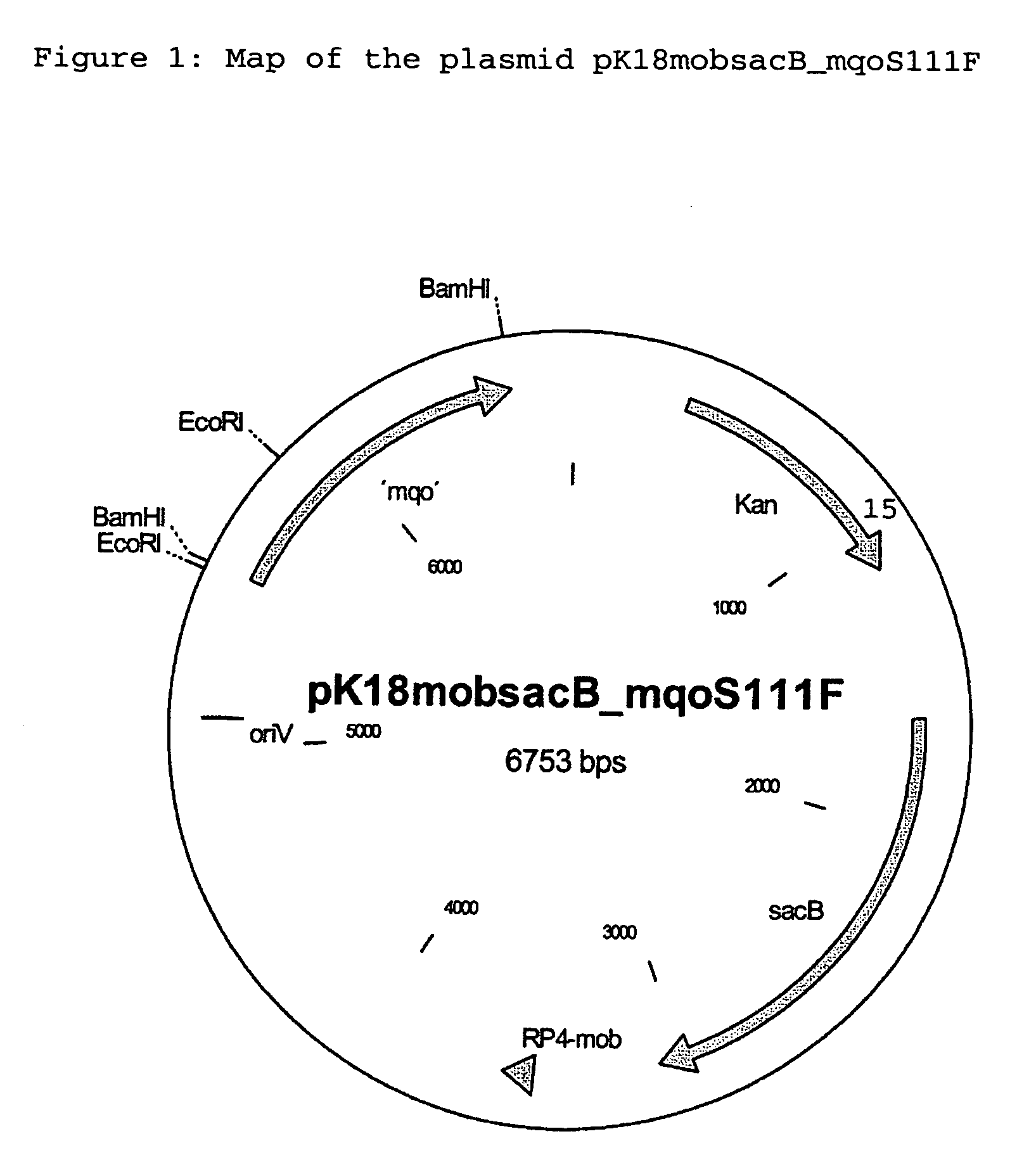Alleles of the mqo gene from coryneform bacteria
a technology of alleles and genes, applied in the field of alleles of the mqo gene of the coryneform bacterium, can solve problems such as inability to make predictions, and achieve the effect of improving the preparation of amino acids
- Summary
- Abstract
- Description
- Claims
- Application Information
AI Technical Summary
Benefits of technology
Problems solved by technology
Method used
Image
Examples
example 1
Mutagenesis of the L-lysine-Producing Strain DM1797
[0247] The Corynebacterium glutamicum strain DM1797 was used as the starting strain for the mutagenesis using N-methyl-N′-nitro-N-nitrosoguanidine (MNNG). The strain DM1797 is an aminoethylcysteine-resistant mutant of Corynebacterium glutamicum ATCC13032 and is deposited in the Deutsche Sammlung für Mikroorganismen und Zellkulturen [German Collection of Microorganisms and Cell Cultures] (DSMZ, Brunswick, Germany) under the designation DSM16833.
[0248] The strain DM1797 was cultured in 10 ml of LB broth (Merck, Darmstadt, Germany), which were contained in a 100 ml Erlenmeyer flask, at 33° C. at 200 rpm for 24 hours on a rotary shaker of the Certomat BS-1 type (B. Braun Biotech International, Melsungen, Germany). The culture was then centrifuged and the sediment was resuspended in 10 ml of 0.9% NaCl solution; the resulting suspension was centrifuged once again and the sediment which was obtained was taken up in 10 ml of 0.9% NaCl so...
example 2
Test of the Performance of the Strain DM1797 Mutants
[0249] The mutants obtained in Example 1 were cultured in a nutrient medium suitable for producing lysine, and the lysine content in the culture supernatant was determined.
[0250] For this, the clones were first of all propagated at 33° C. for 24 hours on brain-heart agar plates (Merck, Darmstadt, Germany). These agar plate cultures were then used for in each case inoculating one preliminary culture (10 ml of medium in a 100 ml Erlenmeyer flask). The medium used for the preliminary culture was MM medium. The preliminary culture was incubated at 33° C. and 240 rpm for 24 hours on a shaker. This preliminary culture was used to inoculate a main culture such that the initial OD (660 nm) of the main culture was 0.1 OD. The MM medium was also used for the main culture.
MM mediumCSL5g / lMOPS20g / lGlucose (autoclaved separately)50g / lSalts:(NH4)2SO4)25g / lKH2PO40.1g / lMgSO4 * 7 H2O1.0g / lCaCl2 * 2 H2O10mg / lFeSO4 * 7 H2O10mg / lMnSO4 * H2O5.0mg / ...
example 3
Sequencing the mqo Gene of the Mutant DM1808
[0254] The method of Eikmanns et al. (Microbiology 140: 1817-1828 (1994)) was used to isolate chromosomal DNA from the DM1808 clone. The polymerase chain reaction was used to amplify a DNA segment carrying the mqo gene. The following oligonucleotides were used as primers for this purpose:
mqo-A1 (SEQ ID NO: 13):5′ ggtgaaacttccgcgatact 3′mqo-E1 (SEQ ID NO: 14):5′ gtgtcgccta aatcacactg 3′
[0255] The depicted primers were synthesized by MWG Biotech (Ebersberg, Germany). They enable a DNA segment which is approx. 2 kb in length and which carries the mqo gene to be amplified. The primer mqo-A1 binds to the region corresponding to position 22 to 41 in the strand which is complementary to SEQ ID NO: 3. The primer mqo-E1 binds to the region corresponding to position 2002 to 1983 in the strand depicted in SEQ ID NO: 3.
[0256] The PCR reaction was carried out using Phusion High Fidelity DNA polymerase (New England Biolabs, Frankfurt, Germany). The...
PUM
| Property | Measurement | Unit |
|---|---|---|
| concentrations | aaaaa | aaaaa |
| concentrations | aaaaa | aaaaa |
| volume | aaaaa | aaaaa |
Abstract
Description
Claims
Application Information
 Login to View More
Login to View More - R&D
- Intellectual Property
- Life Sciences
- Materials
- Tech Scout
- Unparalleled Data Quality
- Higher Quality Content
- 60% Fewer Hallucinations
Browse by: Latest US Patents, China's latest patents, Technical Efficacy Thesaurus, Application Domain, Technology Topic, Popular Technical Reports.
© 2025 PatSnap. All rights reserved.Legal|Privacy policy|Modern Slavery Act Transparency Statement|Sitemap|About US| Contact US: help@patsnap.com

